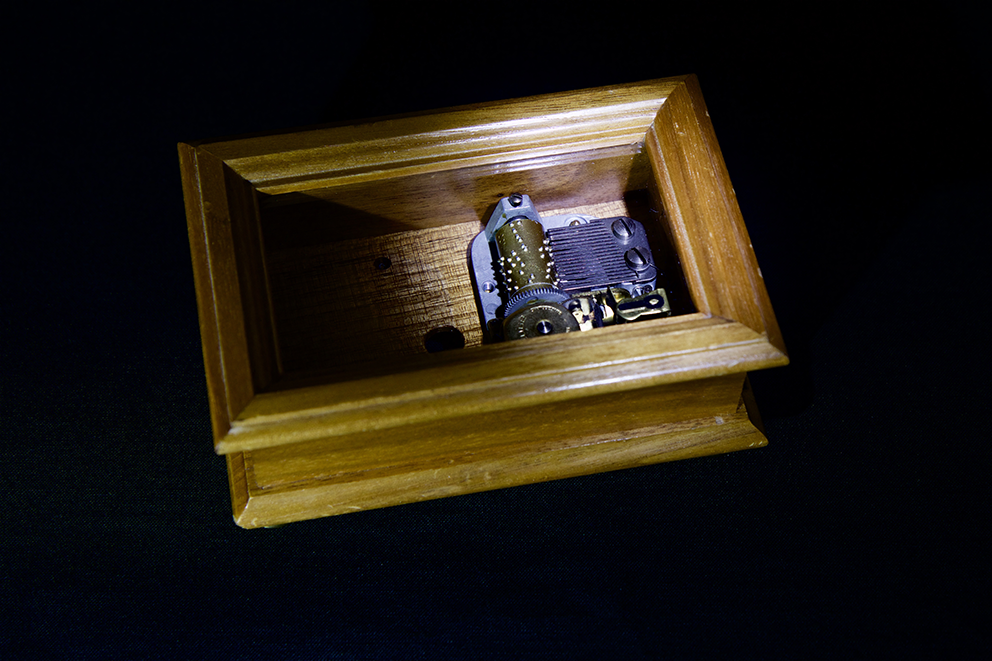MBD for a Music Box
Although this example is not about an industrial component, its dynamics are very complex, and its analysis requires special care. A music box or musical box is an automatic musical instrument in a box that produces musical notes by using a set of pins placed on a revolving cylinder or disc to pluck the tuned teeth (or lamellae) of a steel comb. The mechanism is powered by the elastic energy stored in a spiral spring, which is manually wound. The main drum also powers a micro fan through a gear train with a large transmission ratio. As the fan reaches high speed, the drag torque works as a brake to control the unwinding speed. A virtual prototype of a music box must necessarily include highly flexible bodies and the extended contacts with their surfaces. This is a classic scenario that exploits the best features of RecurDyn software, such as the Full-Flex and the Geo-Contact technology. In order to store the powering energy for the music box, a spiral spring is manually wound. In order to be reliable enough, the virtual model must reproduce both the large deformation of the structure and the contacts occurring along the entire body (self-contacts).


These requirements make the model highly non-linear and, therefore, the classic approaches which would be used in multi-body tools for flexible body simulation are no longer applicable. Only RecurDyn allows the user to choose between two approaches for flexible body simulation: classic linear flexibility (Craig-Bampton theory) and proprietary non-linear flexibility. The first method is called Reduced Flex, while the second is called Full Flex.
The power spring of the music box is clearly a component that could not be simulated without RecurDyn’s efficient Full Flex technology. The steel comb features teeth of variable lengths, which, once plucked, vibrate and produce the notes. If one only considers the amplitude of the deformations, this component could be modelled as a Reduced Flex body. Since the teeth are plucked by small asperities located on the revolving cylinder, we need to set a number of contacts between the rigid cylinder and the steel comb. For this reason, we again need to use RecurDyn’s premium Full Flex technology which really has no limitations.
Since full flex bodies use similar formulations to the standard Finite Elements, the results include both strains and stresses. RecurDyn allows the time evolution of the stress components per each node of the Full Flex body to be exported. The revolving cylinder would reach very high-speed if it was not properly braked. The music box features a microscopic fan, powered by the drum, which provides sufficient drag torque. To make the fun rotate fast, a gear train returns a high transmission ratio between drum and fan. The train includes both a worm gear and toothed gears. All the gears are kept rigid, but very refined surface contacts are used to represent the interaction between the parts. Once again,
RecurDyn’s Geo-Contact technology allows one to control the surfacic tessellation, the numerical smoothing, and the organization of the nodes’ domain so that the contacts perform efficiently. The steel comb, which makes the music by vibrating, has to be modelled using the Full Flex approach. Indeed, we need to set at least one contact per each tooth, and this would not be permitted by linear approaches to flexibility. RecurDyn Implicit Alpha Solver handles this highly non-linear problems without hesitation.
Even in the presence of abrupt changes, such as the one that occurs when the teeth are disengaged, the solver keeps going by simply adjusting the time step. Full Flex’s numerical efficiency remains rather high because the solver is optimized for handling high-frequency dynamics.
